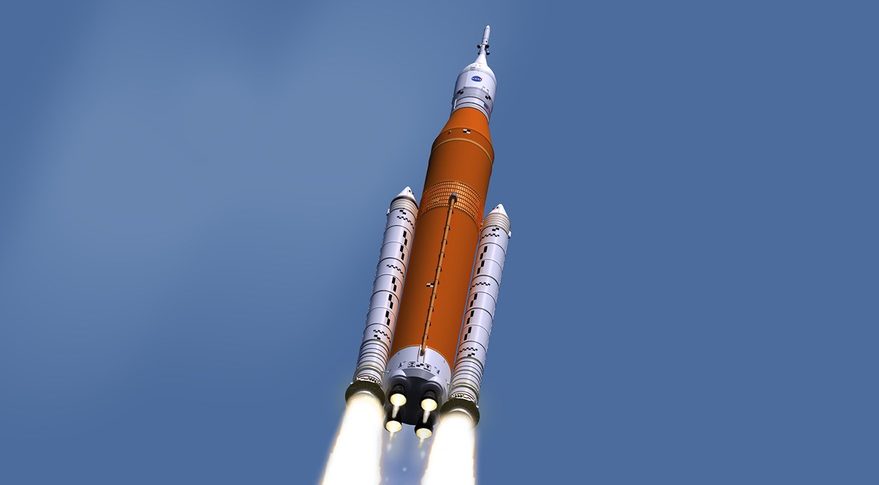NASA Reassessing Date for First SLS Megarocket Launch

WASHINGTON — The director of NASA's Marshall Space Flight Center said March 5 that the agency is "reassessing" the 2020 launch date for the first flight of its Space Launch System, suggesting that the mission may face further delays.
During a question-and-answer session at a Space Transportation Association luncheon here, Jody Singer said the launch readiness date for Exploration Mission (EM) 1 is still in 2020, but did not give a more precise estimate of the date even as NASA reviews possible changes to it.
"We do know that we are reassessing those dates to see if that date will work, based on making sure we have the vehicle ready, and ready to go fly safely," she said. "We are assessing that date. Our launch readiness date is still 2020, and we're doing everything within our power to make sure that we support that."
Related: NASA's Space Launch System for Deep Space Flights in Photos
Singer didn't identify the specific issues with EM-1 that prompted the reassessment, but NASA officials have previously said that the core stage of the SLS, along with the European-built service module for the Orion spacecraft that SLS will launch, were the items on the critical path for the mission.
A report in October 2018 by NASA's Office of Inspector General criticized both NASA and Boeing, the prime contractor for the SLS core stage, for problems with that element. At that time, the office concluded that EM-1 would not be ready to fly in the first half of 2020, as planned by the agency at that time.
Singer, a veteran engineer and manager who became director of NASA Marshall in September 2018, acknowledged issues in the development of SLS in general, whose first launch has slipped from 2017 to at least 2020 over the course of its development. "We are working hard to build SLS and, yes, we're overcoming challenges," she said.
Get the Space.com Newsletter
Breaking space news, the latest updates on rocket launches, skywatching events and more!
Other elements of the SLS are largely complete, she said, including its two five-segment solid rocket boosters, upper stage and adapters. "The SLS vehicle is almost complete. It's in its final outfitting," she said, with the exception of the core stage.
Related: NASA's Space Launch System Explained
Structural test articles of liquid hydrogen and liquid oxygen tanks will be tested in the coming months at Marshall, she said, while the core stage flight hardware is assembled at the Michoud Assembly Facility in New Orleans. That core stage should be and transferred to the Stennis Space Center in Mississippi for so-called "green run" testing, when its four RS-25 engines are fired on a test stand, "in the late part of this year or early part of next year."
Another issue with the SLS is development of the Exploration Upper Stage (EUS) that will be used on the future Block 1B version of the rocket. While NASA planned to shift to the Block 1B on the second SLS flight, the agency instead expects to fly the original Block 1 version, with its Interim Cryogenic Propulsion Stage, for at least three missions.
Boeing said last October that it had slowed down work on the EUS at the request of NASA, and was looking at ways to refine the stage's design in order to increase its performance. That would enable it to increase the amount of co-manifested payloads, such as elements of NASA's planned lunar Gateway, it could carry on missions that also include the Orion spacecraft.
Singer said that NASA had made "significant steps" on the design of the stage, with a critical design review scheduled for late this year. "A critical part of designing the upper stage is making sure we understand the mission and the components that we need to take and where we need to go," she said. "We are making definite forward progress on the upper stage."
The report accompanying the final fiscal year 2019 appropriations bill funding NASA directed that at least $150 million of the $2.15 billion provided for SLS be directed to work on the EUS. It also stated that the EUS, along with a second mobile launch platform built specifically for the Block 1B version of SLS, be ready for flight no later than 2024.
Funding has, in general, not been an obstacle for development of the SLS. A major factor in that has been the support of Sen. Richard Shelby (R-Ala.), chairman of the Senate Appropriations Committee. Shelby appeared briefly at the luncheon to introduce Singer.
"As chairman of the appropriations committee, I have more than a passing interest in what NASA does. And I have a little parochial interest, too, in what they do in Huntsville, Alabama," where Marshall is based, he said. "Jody, you keep doing what you're doing. We'll keep funding you."
- Latest News About NASA's Space Launch System
- The World's Tallest Rockets: How They Stack Up
- Boeing Plans Changes for Upper Stages NASA's SLS Megarocket
This story was provided by SpaceNews, dedicated to covering all aspects of the space industry.
Join our Space Forums to keep talking space on the latest missions, night sky and more! And if you have a news tip, correction or comment, let us know at: community@space.com.

Jeff Foust is a Senior Staff Writer at SpaceNews, a space industry news magazine and website, where he writes about space policy, commercial spaceflight and other aerospace industry topics. Jeff has a Ph.D. in planetary sciences from the Massachusetts Institute of Technology and earned a bachelor's degree in geophysics and planetary science from the California Institute of Technology. You can see Jeff's latest projects by following him on Twitter.










